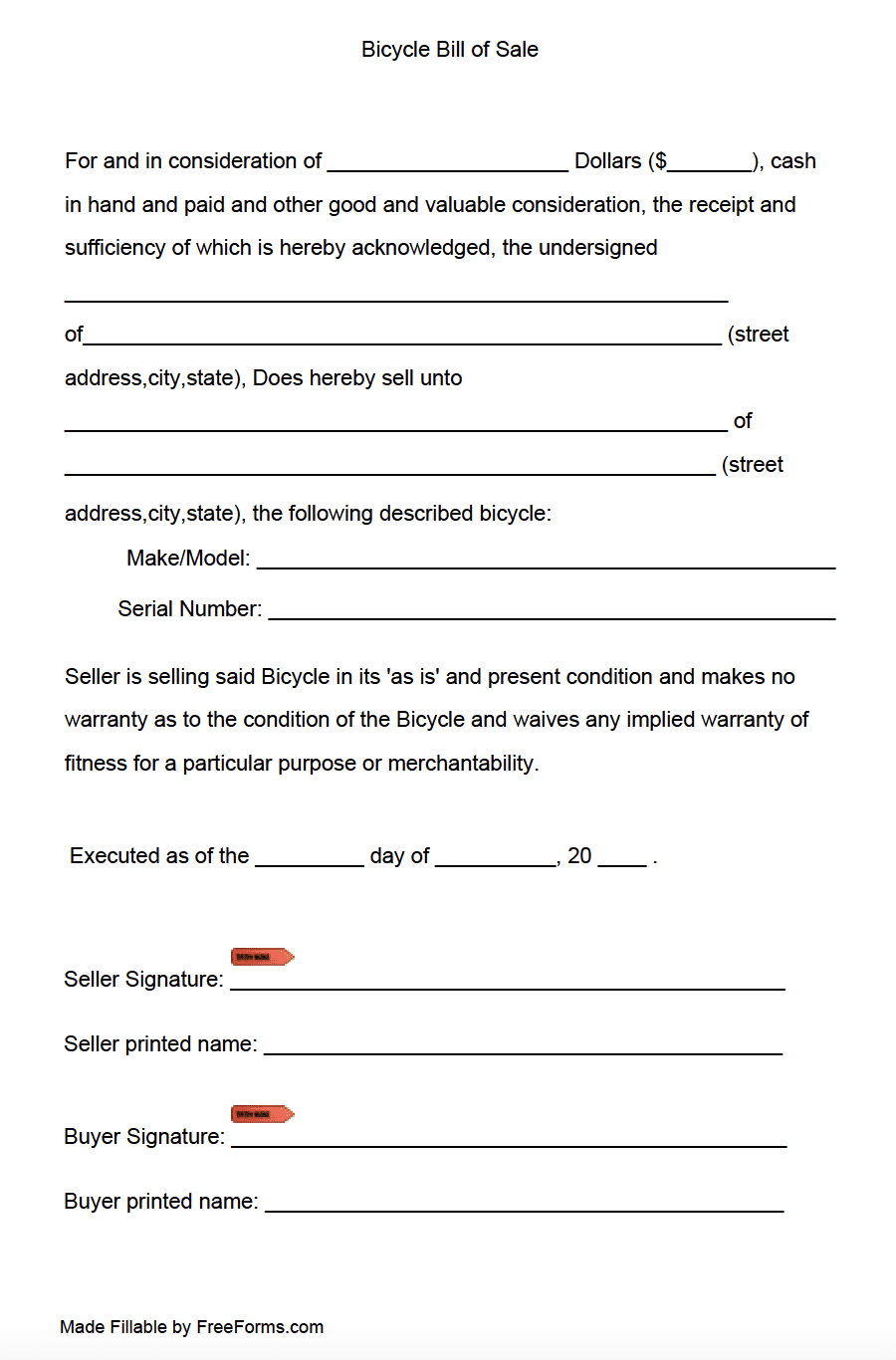a Bicycle Bill of Sale form is a concrete agreement signifying the transfer of a bicycle from on owner to the next for a predetermined payment amount. The instrument logs the important information involved in the sale, recording buyer and seller particulars, identification distinctions of the bicycle, condition, date, and separate signatures to indicate accord in the contract.
Do I Need a Bill of Sale?
When selling or purchasing a used bicycle its always a good idea to have some kind of record of the transaction for a number of reasons. First off, it will bring a written transparency to the exchange and will address any issues that the bike may have before it is sold, ensuring the buyer is aware of the ‘as is’ condition. A bill of sale also supplies the buyer and seller with evidence of the purchase, this can be utilized should there be any question as to ownership should the bike be stolen. It can also be furnished to provide liability to the buyer in the chance it had any illegal involvement prior to the sale.
How to Sell a Bicycle
-
Clean the Bicycle and Repair any Major Damages
To attain the highest possible sales price for your bicycle you will want to clean it top to bottom. You can use soap and water, sponges and a soft brush to get any dirt or grease off of the frame and tires. Keep in mind you will want to keep water away from the gears, shocks and other moving parts in to avoid any malfunction down the road. You can even apply a light wax for the frame, shine for the tires and lube on the chain to enhance the overall appearance. If there are any major damages to the bike it will be in your best interest to take care of them before listing. You may even want to consider getting your bike tuned prior to sale to have further material evidence of the bike’s exceptional condition when it comes to negotiation.
-
Determine the Proper Sales Price for Your Bicycle
It’s important to to understand the bike’s value before selling, take the time to research your bike’s make and model. First, check your bicycles listed value at bicyclebluebook.com, this will give you the best idea as to where your bike stands. Next, you will want to check the new and used prices and find at least 3 comparative local examples for sales in online classifieds, at area pawn shops, and anywhere else you can find. You will also want to take into account any modifications you have made to the bike and the cost of additional accessories when it comes time to consider your sales price. Keep in mind a buyer looking for a used bike will generally want to pay less than the asking price, so anticipate this and list accordingly.
-
Advertising Your Bicycle
When listing your bicycle you will want to include all relevant information on the bike, such as year, make, model, size, condition, and any recent maintenance that it has undergone. Photos of the bike can be your greatest asset, so make sure you photograph it from all angles, along with close-ups of the bicycle’s component parts. If there are any imperfections, scratches or dents, highlight these in your pictures to let any potential buyer aware ahead of time, to avoid renegotiation for any surprises. There are many ways to list your bike as well. Word of mouth through friends and family, making flyers to put on bulletin boards in local bike shops, or repair centers can be advantageous in the search of buyers. Online sources such as Craigslist, bicycle-geared classified websites and eBay can reach a higher volume of potential buyers, or if you are interested in sites that do the selling for you, you can simply send your bike into reputable consignment resellers like protestedgear.com or theproscloset.com.
-
Conducting the Sale
When it comes time to meet with a possible buyer, you will want to arrange to do so in a public place. You can take time to allow the individual to look over the bike and check for any issues and negotiate on the price for the bike. Use common sense, if the buyer wishes to test-ride, make sure you receive sufficient collateral before letting them take off with your bike. When you have reached an amicable agreement on the purchase price, both parties are then ready to sign and date the bill of sale and exchange the money for the bicycle. Cash is usually your safest bet with a transaction like this, just make sure to hold the bills up to the light to ensure the money is authentic tender and complete the deal.
How to Complete the Bicycle Bill of Sale Form
Once you have found an interested purchaser of your bicycle and you have negotiated a price
Step 1 – First, download the Adobe PDF and then open the file.
Step 2 – Enter the purchase price in the first two spaces in the following methods:
- Written Purchase Price
- Numerical Purchase Price
Step 3 – Seller/Buyer Information – On the next lines you will want to provide the information relative to the individuals selling and purchasing the bike:
- Seller’s Name
- Seller’s Address
- Buyer’s Name
- Buyer’s Address
Step 4 – Bicycle Information – Complete the technical information on the bicycle being sold:
- Make and Model
- Serial Number
Step 5 – Date and Endorsements – To finalize the form, date, sign, and provided printed names in the following order:
- Date of Signatures
- Seller’s Signature
- Seller’s Printed Name
- Buyer’s Signature
- Buyer’s Printed Name
